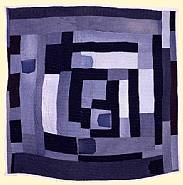There was no reason at all to make ricotta cheese this weekend. Most of the family doesn’t even like it. But there was a back-of-the-book recipe in Gourmet recently, and it got me reminiscing about Tony’s and my glorious trip to Italy, the summer between our marriage and my first pregnancy. We travelled with good friends, gorging on art and wine and food.
In Bologna, we ate in a small restaurant that was dominated by a dark wood, marble-topped hutch. It held bowls of beautiful antipasti: roasted peppers, olives, ricotta cheese, and more. The waiter brought us a selection while we waited for our entrees, and we ate the sweet, creamy ricotta by the spoonful. It was unlike anything I’d ever had before; as similar to American grocery store ricotta as clotted cream is to Dannon yogurt .
So I had to see if making it at home was a) as simple as advertised (“Got 5 minutes?” is the Gourmet headline) and 2) as delicious as the Bologna ricotta.
Simple, yes, though it takes more than 5 minutes. Maybe 10. As delicious? Well, the Bologna ricotta had a whole lot of atmosphere going for it that we can’t really reproduce here, but it’s pretty darn good. We ate it with grilled vegetables for dinner. I think tomorrow I’ll grill some peaches, and serve the ricotta on those with a drizzle of maple syrup. It’s not cheap to make; I used Strauss (a local dairy) organic milk and cream, so my half pound of cheese probably cost $10. To compensate for that, I did not discard the milky liquid that I strained off the curds. I figure it’s basically a rather thin buttermilk, and I’ll turn it into a few loaves of bread or biscuits or something. I’m cheap that way.
Since embarking on this recipe, I’ve found a couple more; one in Suzanne Dunaway’s No Need to Knead (a great cookbook for bread and random tasty accompaniments), one over here. I’m curious to try these different recipes and compare them to what I did (particularly Dunaway’s, since she calls for yogurt — a staple in my house– instead of cream or buttermilk). The one fussy bit of equipment you need is some cheesecloth, though probably you could make do with a well-loved dishtowel.
The recipe:
2 quarts whole milk
1 c cream
1/2 tsp salt
3 tbsp lemon juice (I just used the juice of one lemon)
Line a large sieve with a layer of cheesecloth and place it over a large bowl.
Bring the milk, cream, and salt to a boil in a heavy pot over moderate heat, stirring occasionally to prevent scorching. The milk can go from nearly-boiling to boiling over very quickly, so don’t totally ignore it. Add the lemon juice and reduce heat to low and simmer, stirring constantly, until the mixture curdles. This only takes 2 or 3 minutes, but mine didn’t seem quite curdled enough at that point, so I simmered it for 4 or 5 minutes longer.
Now, pour the hot milk mixture into the lined sieve and let it drain for an hour. Serve as is, or cover and refrigerate.






